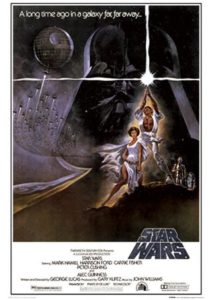 With Wednesday’s announcement from Fox and LucasFilm of the full content of the forthcoming Star Wars Saga on Blu-ray, the powers that be put the final nail in the coffin for fans hoping to see high-def restorations of the original trilogy on the digital format. Creator George Lucas has long stated that the Special Editions released in 1997, coinciding with the first film’s twentieth anniversary and a forerunner to the prequel trilogy, are the only ones he will be releasing. “The other versions will disappear”, stated Lucas in an interview with American Cinematographer.
With Wednesday’s announcement from Fox and LucasFilm of the full content of the forthcoming Star Wars Saga on Blu-ray, the powers that be put the final nail in the coffin for fans hoping to see high-def restorations of the original trilogy on the digital format. Creator George Lucas has long stated that the Special Editions released in 1997, coinciding with the first film’s twentieth anniversary and a forerunner to the prequel trilogy, are the only ones he will be releasing. “The other versions will disappear”, stated Lucas in an interview with American Cinematographer.
What are the original versions? While the official site states that there are only two versions, the 1977 and the 1997, we also know that they were changed again in 2004 for the DVD release of the film. Yet when most people talk about the “original versions”, it is often forgotten that Lucas began tinkering with the films as far back as 1981.
It is a period of civil war…
The first changes began to Star Wars in 1981, following the 1980 release of The Empire Strikes Back, with the addition of a few lines of text to the famous opening crawl. Anybody who has seen the films since the VHS age will be largely unaware that these changes were ever made. Principally, the lines “Episode IV: A NEW HOPE” (now the official title for the film) were added for consistency with “Episode V: THE EMPIRE STRIKES BACK”, and the words “Rebel spies” were given a capital ‘R’. This also changed the timing and the music cues of the much-parodied text, and is the first major revision made to the ‘original’ trilogy.
There were a number of other changes made in the pre-Special Edition wilderness years. When the original 70mm 6-track audio version of the film was converted to 35mm mono soundtrack for a wider release, some key dialogue changes were made that have now become immortalised in later versions: “close the blast doors!” and C-3POs line about the tractor beam were added, Princess Leia firing a blaster that sounds like a Magnum .44 and during the Death Star trench run Luke’s line “Blast it, Biggs, where are you?” is altered to “Blast it, Wedge, where are you?”. This was changed to reflect the deletion of several scenes with the otherwise unseen character of Biggs. However, this line was changed back in later versions, especially given Biggs finally appeared just prior to Luke hopping in an X-Wing.
There were, of course, a number of minor technical and mastering changes made for the various VHS and Laserdisc editions over the years, in 1985 for VHS/Laserdisc and in 1993 for the Definitive Laserdisc Edition, including some colour correction and the removal of the C-3PO tractor line. In 1995, VHS editions of the film were released with restored remastered picture and sound. At the time, Lucas declared that it would be the last time that the films would be available in that state.
Han shoots last
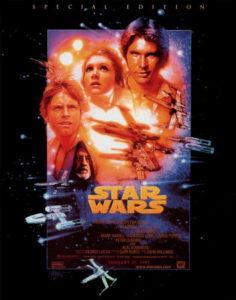 The twentieth anniversary of the original Star Wars was always going to be a special occasion for fans, and 1997 couldn’t be a better year for the community. Not only would the original trilogy be re-released to cinemas for the first time in years, but shooting had begun on a new prequel trilogy in the same Tunisian desert that united Luke, Obi-wan and the droids under a binary sun two decades prior. The Phantom Menace, the first of these prequels, would employ state-of-the-art CGI animation and special effects to bring Lucas’ vision to life, and the director saw it as important to match the look-and-feel of what would eventually become a six-part saga.
The twentieth anniversary of the original Star Wars was always going to be a special occasion for fans, and 1997 couldn’t be a better year for the community. Not only would the original trilogy be re-released to cinemas for the first time in years, but shooting had begun on a new prequel trilogy in the same Tunisian desert that united Luke, Obi-wan and the droids under a binary sun two decades prior. The Phantom Menace, the first of these prequels, would employ state-of-the-art CGI animation and special effects to bring Lucas’ vision to life, and the director saw it as important to match the look-and-feel of what would eventually become a six-part saga.
Promising to show the entire trilogy “the way it was meant to be experienced”, the promotions for the re-released saga revealed that audiences would not be experiencing the same films that first captivated crowds in 1977, 1980 and 1983 respectively, with all three films gaining new special effects, and in some cases, entire new scenes.
At a cost of over 10 million dollars, not insubstantial at the time, the changes to the trilogy were controversial to say the least. They added a number of story elements that did not exist in the original films along with special effects that would have been impossible with 1977 technology. The full list of changes can be found at the Internet Movie Database (IMDb), and they range from small cosmetic changes to major new scenes and special effects.
The first of these changes can be seen with the addition of a few digital dewbacks on Tatooine, and a few new establishing shots in between, but the most obvious of these would come when we reach Mos Eisley: a wretched hive of scum, villainy and digital puppets. Additional Jawas, large dinosaur-like creatures and new Stormtroopers can be scene scouring the port. Very much the elephant in the room was the new Jabba the Hutt scenes, prior to Han taking off with Chewie and his new passengers. As seen in the clip below, the deleted 1977 scenes saw Hutt as simply a rotund human (Declan Mulholland) giving Han an ultimatum. However, fans will know he didn’t ultimately appear until 1983’s Return of the Jedi as a multi-operator puppet. For the 1997 and 2004 re-releases, LucasFilm digitally inserted a creature consistent with the Jedi puppet. While this looked good, it diminished somewhat from the spectacular reveal of Hutt in the final film, a character who has been built up to be the only threat to the cocky, scruffy-looking Nerf herder Han Solo.
Speaking of Han, the largest amount of outrage at the changes was directed at one scene in particular. You know the one. Bounter hunter Greedo has Han Solo cornered, so Han shoots him. In the 1997 version he still does, but he doesn’t fire first. The roguish smuggler who won our hearts is now simply reacting to being shot at, quite a reasonable reaction one would think, but does this detract from his essential Han-ness? For most people, this is the deepest cut (or addition as it were) of all, for in a singular moment the audience no longer sees Han as the ‘shoot first, ask questions later’ kind of guy that his association with Luke and Leia will later begin to erode. ‘Han shoots first’ is not simply a convenient slogan for t-shirts at comic conventions, but a declaration of the fan’s love of of all that is Solo about Han.
A few digital tracking shots of X-Wings and Y-Wings, some revised sound and vision and a trench run later, the Death Star still gets what’s coming to it. Defying everything we know about physics in space, the explosion now has its very own shockwave, ensuring that the spinning Darth Vader will well and truly mess up the inside of his helmet. Speaking of Vader, the end credits add one very overdue change: the correct attribution of James Earl Jones in the credits. Star Wars would never be the same again.
A New(er) Hope
So when the DVDs finally hit shelves in 2004, fans expecting cuts of the original films were solely disappointed. Not only were the fiddled-with versions the only editions released to eager punters, but additional changes were made to the trilogy. John D. Lowry digitally restored and visually enhanced the films for the DVD format, including colour correction and enhancements for 5.1 surround sound. However, a number of new visual enhancements were made, include re-doing the special effects during the Jabba the Hutt scene to be consistent with the model seen in the prequel trilogy. Indeed, as the clip below demonstrates, in the 7 short years between the 1997 enhancements and the 2004 ones, special effects had come a long way:
Does this mean the film will need touching up every few years? Indeed, 23 changes were made to the 2004 edition, on top of the almost 30 alterations to the 1997 edition, some of which removed additions to the previous alterations! Most of these changes are very minor, and only the most dedicated of viewers will notice the non-SFX changes to the film, but that further begs the question: if they are so minor, why bother making them at all? In 2006, a Special Edition of the DVDs were released with the ‘original’ films as bonus discs, but in non-anamorphic 4:3/stereo sound transfers, this felt like another kick in the teeth to faithful fans who now had several shelves dedicated to Star Wars re-releases.
The Force is still with us
So how original is ‘original’? Some sources indicate that, excluding TV edits and the ‘Pan & Scan’ VHS releases, there are at least 10 different versions of the film released to date. Some could argue that we’ve not seen an ‘original’ version of the film since 1981, and it has simply never stopped changing. Perhaps Star Wars is the kind of film that needs to keep evolving every so often to find a new audience, or maybe it is just better left alone.
Whether Lucas is right or not, other directors (including Steven Spielberg) have got away with far worse changes (see: E.T.: The Extra Terrestrial) and several versions of Close Encounters of the Third Kind. Ridley Scott actually tightened perfection (Alien) and has managed to tweak Blade Runner through both a Director’s and Final Cut to critical and fan acclaim. So what is it about George Lucas’ changes to Star Wars and its sequels that so raises the fists of us geeks everywhere? Is it just that the films are so beloved and iconic, or more that George Lucas has stubbornly refused to listen to fan requests to make the original films available?
No indication has been made that the ‘original’ versions will see the light of day in hi-def, and we know at least one change is forthcoming with the promise of “gorgeous high definition and with pristine, 6.1 DTS Surround Sound”. Something tells us that while The Lucas is under the hood tinkering with the sound and vision, he may take another look at those 2004 special effects and wonder if they could use a tweak. Either way, they’ll fly off the shelf like a suped-up podracer.
Star Wars: The Complete Saga will be available on high-definition Blu-ray in Australia on 12 September 2011 from Fox. Let us know if you’d like us to look at the rest of the Trilogy!

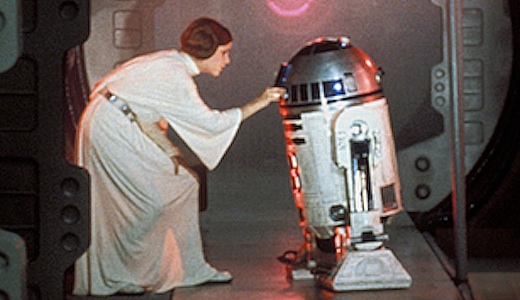
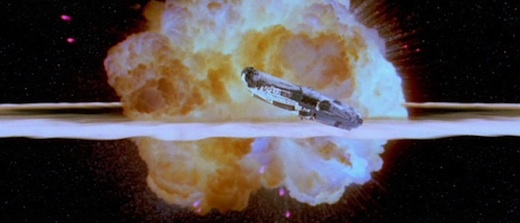
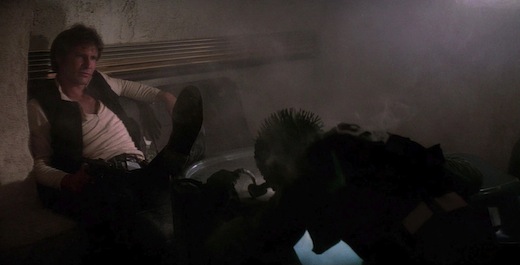

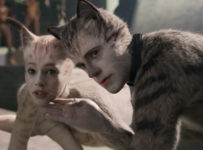

I’ve never begrudged Lucas’ alterations. I’ve felt from the start that he made a film that was his vision and new tech was invented to make it as close as possible. However, he didn’t achieve exactly what he wanted, so he tweaked. I feel it’s his vision, not ours, so he has the right to do so. I don’t always agree. “Han shot last” is the only thing I feel is not right. I like the tweaks that make the prequel trilogy meld with the original so that they make sense.
Having said all that, I’d like to see the original films again, as I’d like to see what’s changed.
I don’t mind him tweaking; however, I would blow my stack if the films were ever remade. That’s sacrilege.
The alterations themselves are not an issue, agreed. Yet making the unaltered versions completely unavailable (unlike the Spielberg and Ridley Scott examples I gave) is my main gripe. However, the main reason I wrote this little piece was to point out that even the ‘originals’ (which for millions of people will be the ones they enjoyed on VHS) have been altered at least since 1981.